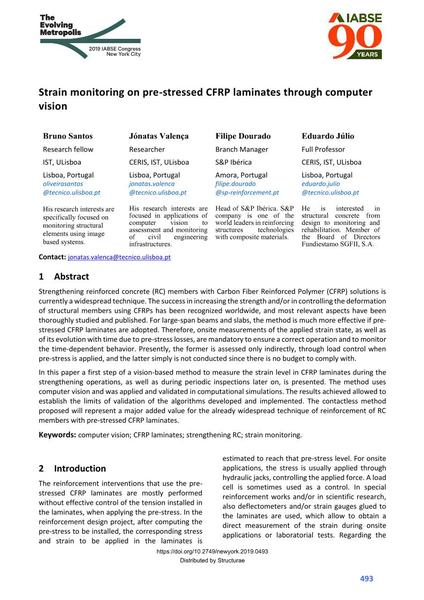Strain monitoring on pre-stressed CFRP laminates through computer vision

|
|
|||||||||||
Détails bibliographiques
| Auteur(s): |
Bruno Santos
(IST, ULisboa)
Jónatas Valença Filipe Dourado (S&P Ibérica) Eduardo Júlio |
||||
|---|---|---|---|---|---|
| Médium: | papier de conférence | ||||
| Langue(s): | anglais | ||||
| Conférence: | IABSE Congress: The Evolving Metropolis, New York, NY, USA, 4-6 September 2019 | ||||
| Publié dans: | The Evolving Metropolis | ||||
|
|||||
| Page(s): | 493-497 | ||||
| Nombre total de pages (du PDF): | 5 | ||||
| DOI: | 10.2749/newyork.2019.0493 | ||||
| Abstrait: |
Strengthening reinforced concrete (RC) members with Carbon Fiber Reinforced Polymer (CFRP) solutions is currently a widespread technique. The success in increasing the strength and/or in controlling the deformation of structural members using CFRPs has been recognized worldwide, and most relevant aspects have been thoroughly studied and published. For large-span beams and slabs, the method is much more effective if pre- stressed CFRP laminates are adopted. Therefore, onsite measurements of the applied strain state, as well as of its evolution with time due to pre-stress losses, are mandatory to ensure a correct operation and to monitor the time-dependent behavior. Presently, the former is assessed only indirectly, through load control when pre-stress is applied, and the latter simply is not conducted since there is no budget to comply with. In this paper a first step of a vision-based method to measure the strain level in CFRP laminates during the strengthening operations, as well as during periodic inspections later on, is presented. The method uses computer vision and was applied and validated in computational simulations. The results achieved allowed to establish the limits of validation of the algorithms developed and implemented. The contactless method proposed will represent a major added value for the already widespread technique of reinforcement of RC members with pre-stressed CFRP laminates. |
||||
